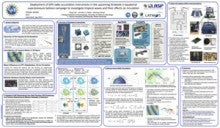Deployment of GPS radio occultation instruments in the upcoming Strateole-2 equatorial superpressure balloon campaign to investigate tropical waves and their effects on circulation
Bing
Cao
Scripps Institution of Oceanography, University of California, San Diego
Poster
Deep tropical convection influences the transport of mass and momentum from the equatorial upper troposphere into the lower stratosphere through the generation and interaction of waves at a broad range of scales. The France-US collaborative Stratole-2 project will explore equatorial waves in the tropopause region with super-pressure balloons, designed to drift on a quasi- Lagrangian trajectory in the lower stratosphere. The Stratole-2 research program will begin with a five-balloon technology validation campaign launched from the Seychelles Islands in the Indian Ocean in boreal fall-winter 2018–2019, followed by 20-balloon flights in boreal fall-winter 2020–2021. A final 20-balloon campaign in 2023–2024 is planned for the opposite phase of the Quasi-Biennal Oscillation (QBO). In the 2020–2021 campaign, ten balloons will fly near 20- km altitude, just above the Tropical Tropopause Layer (TTL), and another ten near 18-km altitude, within the TTL, each with an expected duration of approximately 80 days. Four of the balloons at 20 km altitude will carry the Radio OCcultation (ROC2) instrument to execute a continuous sequence of temperature profiles on either side of the balloon trajectory to sample the equatorial wave field in three dimensions, and will carry a new French micro- lidar for detecting cirrus and convective cloud tops. The objective of the observations is to capture consistent descriptions of the horizontal and vertical structure of tropical waves that impact cirrus formation and to investigate the relationships of waves to convective clouds. The GPS measurements help quantify wave activity in two ways: by providing precise estimates of balloon velocity and height perturbations due to waves and by providing refractivity profiles that are sensitive to vertical temperature fluctuations caused by waves.
This presentation will provide an overview of the plans for the Strateole-2 campaign, and a description of the ROC2 instrumentation that will be deployed in the 2018 technology val- idation campaign. Results from the analysis of superpressure balloon positioning data with similar instruments during Antarctic flights in 2010 will be shown to demonstrate the improved capability to resolve orographically generated gravity wave intrinsic frequency needed for grav- ity wave parameterizations in models. The impacts of the position improvements on the final gravity wave parameters show larger difference in momentum flux for the shorter scale grav- ity waves than for the longer scale waves, and significant difference in the distribution of the intrinsic phase speed. The equatorial campaign will provide complementary information on convectively-generated gravity waves, also required for gravity wave parameterizations.
This presentation will provide an overview of the plans for the Strateole-2 campaign, and a description of the ROC2 instrumentation that will be deployed in the 2018 technology val- idation campaign. Results from the analysis of superpressure balloon positioning data with similar instruments during Antarctic flights in 2010 will be shown to demonstrate the improved capability to resolve orographically generated gravity wave intrinsic frequency needed for grav- ity wave parameterizations in models. The impacts of the position improvements on the final gravity wave parameters show larger difference in momentum flux for the shorter scale grav- ity waves than for the longer scale waves, and significant difference in the distribution of the intrinsic phase speed. The equatorial campaign will provide complementary information on convectively-generated gravity waves, also required for gravity wave parameterizations.

Poster PDF
Abstract file